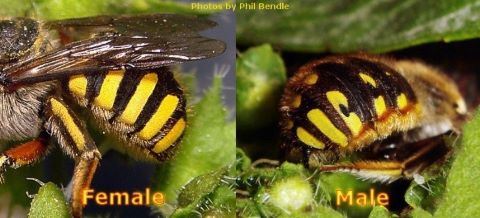European wool carder bee
In January 2019, Agriculture Victoria received an unconfirmed report of a European wool carder bee (Anthidium manicatum) in Maffra, Victoria.
In March 2020, bees collected approximately 17 km away in nearby Sale, were positively identified as Anthidium manicatum.
The European wool carder bee has been assessed as unlikely to have any significant impacts and not feasible to eradicate from Australia. No further action is planned in relation to this bee species.
This species of solitary bee is native to parts of Europe, Asia, and Africa and present as an introduced species in North and South America and New Zealand. The name comes from the female’s behaviour of scraping or ‘carding’ hair from leaves, which they roll into little balls to line their nests.
Part of the Megachilidae family, European wool carder bee is not related to the European honey bee (Apis mellifera) commonly found in Australia.

Identifying the European wool carder bee
The European wool carder bee is black with yellow markings or spots on its face, back and abdomen and is covered with yellow-grey hairs. The bee has a wingspan of approximately 20 mm and body length of 11 — 13 mm for females, and 14 — 17 mm for males.
Female bees have a retractable sting. Male bees do not have stings because stings in Hymenoptera are modified ovipositors. However, male European wool carder bees have 5 sharp spikes on their abdomens used to defend floral resources (their territories) from other males and will also aggressively chase other pollinators from their territory.
Both males and females will hover near flowers. They are generalists, collecting pollen from plants across a variety of families although They can exhibit a preference for blue and purple flowers.
This bee typically builds its nests in high locations using existing holes present in timber, masonry, soil, wood piles, buildings or plant stems. The most common plants used by females to harvest leaf hairs for nesting material include lamb’s ears (Stachys byzantina) and other plants in the mint family (Laminaceae).

Impact
According to a New Zealand study, the European wool carder bee has not had any significant environmental impacts on New Zealand’s flora and fauna. Although males are aggressive, they seldom attacked native bees or pollinators outside of their territory.
The European wool carder bee does not present a threat to commercial or hobby beekeeping because it is a solitary bee that does not swarm or attack hives.
European wool carder bee does not sting or otherwise attack humans, livestock or pets and does not damage infrastructure.
Although European wool carder bee has so far only been found in Victoria, a related Megachilid, the meter-box bee (Afranthidium repititum), was found in Brisbane in 2000. The meter-box bee has since been found in Melbourne (2015) and South Australia (2016). Despite its rapid spread, it has not had any significant impact on agriculture or native bee populations, and it is expected that this will also be the case for the European wool carder bee.
Consideration of the European wool carder bee by the National Biosecurity Management Consultative Committee (NBMCC) following the led to the decision that it is not nationally significant, as defined by the National Environmental Biosecurity Response Agreement. Available evidence suggests that European wool carder bee is unlikely to have significant impacts on the environment, human health, social amenity, infrastructure and business activity.
The NBMCC also agreed that European wool carder bee is not technically feasible or cost beneficial to eradicate from Australia. It is a solitary bee that nests in existing cracks and cavities of a variety of natural and artificial substrates, making it difficult to detect and treat. The bees ability to move by flight and by hitchhiking within the cavities of a wide range of materials also make tracing and containment activities difficult.
The NBMCC will recommend these outcomes to the National Biosecurity Management Group (NBMG).
Download the factsheet:
Encountering European wool carder bee
There is no need to report European wool carder bee if you are confident of its identity. If you are unsure or have found any other unusual pest or disease, secure it and report it to the Exotic Plant Pest Hotline on 1800 084 881.
Alternatively, email photos of the suspected pest, along with your contact details and the pest's location to plant.protection@agriculture.vic.gov.au.
Photo credits
Figure 1 and 2 courtesy of Phil Bendle.
Reporting a honey bee pest or disease
Report any unusual pest or disease of honey bees immediately using our online reporting system or by calling the Exotic Plant Pest Hotline on 1800 084 881. Early reporting increases the chance of effective control and eradication.
Please take multiple good quality photos of the pests or symptoms of disease to include in your report where possible, as this is essential for rapid pest and disease diagnosis and response.
Your report will be responded to by an experienced staff member who may seek more information about the detection and explain next steps.
Report now